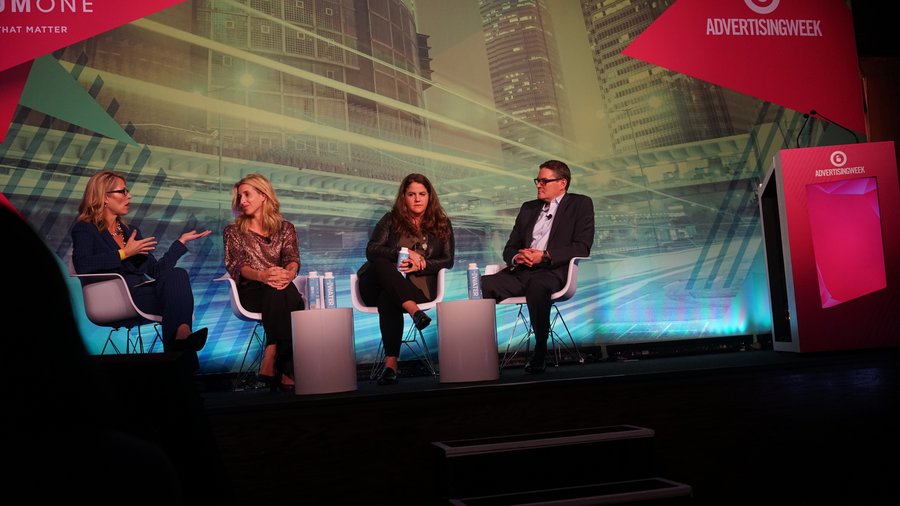While e-commerce sales figures continue their steady climb, even Birchbox chief executive officer Katia Beauchamp, whose core business is a digital subscription service for beauty products, doesn’t foresee a future in which consumers robotically shop from their sofas.
“I don’t think anyone wants to live in a world like ‘ Wall-E,’ where all of our discretionary, free time is screen time,” Beauchamp said at an Advertising Week panel titled “The Third Screen: Innovating Retail for a Changing Customer,” Tuesday afternoon at Liberty Theater.
That said, for many retailers the physical retail space has built-in challenges, at least when existing on its own, she says.
“Retail’s tough and all of your lifetime value of the consumer exists in four walls,” Beauchamp said. “We want [our retail business] to be sometimes in those four walls, but also in your digital device that you have with you all the time, and that’s the Holy Grail.”
After launching Birchbox’s first store in SoHo, the company found that it not only expanded the business’s reach with its “Disney for beauty” atmosphere that combined the digital and physical experience, but immediately multiplied by three the lifetime value of customers who visited the store versus those who did not.
Inside, some 80 percent of the items are arranged not by brand name (as department stores or Sephora do) but by category. Eye shadows from one brand are next to eye shadows by another, and all the product information, reviews and editorial information are accessible as if you’re shopping online.
By providing an experience, such as being able to create your own Birchbox, and the chance to learn and test out products and trends, the store provided the best of both worlds, and it does it for people she describes as “beauty normal,” shoppers, people who enjoy and need but do not obsess over the product for its own sake.
“What Birchbox got really lucky with, is the future of how we spend our time, is we’re not going to have to compromise anymore,” she said. “You get to have fun and entertainment, but you’ve got efficacy….you can’t say goodbye.“
Michael Goldban, senior vice president of retail leasing for Brookfield Property Partners says his company aimed to create a new kind of shopping center at Brookfield Place (formerly the World Financial Center), a “playground for millennials,” if you will, at a time when the Financial District is becoming an increasingly popular place for both residents and businesses.
“What we try to do in our places, is we want to create a canvas where the creative [brands] come in and explore and dream big and think big,” he said. “How do we make it a place where people want to come in and eat, people want to shop, and people want to live?”
Food has become a very pivotal part of shopping, he says. At Brookfield, there are more than a dozen different places to get a bite, and friends and family can split up to choose different eateries in between shopping at stores such as women’s fashion retailer Diane von Furstenberg and watch retailer Omega.
As digital grows, he still thinks that makes the physical store that much more important, provided it has the right experience.
“The two questions I ask [prospective retail tenants] is ‘What are you guys going to be differently?’ and ‘What is your store going to look like?’” he said. .
One thing Brookfield does is use its event team of 10 staffers to create programs in its public spaces within the center. To bring in a diverse audience, they’ve hosted everything from hosting everything from best burger contests to Shakespearean productions.
Rachel Shechtman, CEO and founder of Story, a 2,000-square-foot shop in the Meatpacking District, agrees.
“Since the beginning our mantra was experience per square foot, versus sales per square foot,” she said.
Her store is famous for changing the store’s look and contents entirely, like an art gallery, every month or two to focus on different themes and to represent a magazine-like point of view. It’s not just a store to shop in, but a place for ideas and events, such as yoga classes and to learn about the people who make the product.
“It’s B2B audience, looking to us as a living lab,” Shechtman said. “It’s a showroom, it’s a tradeshow, it’s a press release, and it’s a store.”
Down the road, stores may not even be places to shop as brands, the panelists agreed pointing to brands like Samsung, which opened its Samsung 837 showroom in Manhattan's Meatpacking District, where the focus is on demonstrations, events, and virtual reality experiences, and there is no shopping, save the opportunity to buy food and drink. Sony has opened a similar showplace for its entertainment and technology.
Shechtman says she was dazzled by the efficiency she met after visiting a Blue Cross/Blue Shield store (she didn’t even know such a thing existed) providing customer service that beats waiting on the phone.
“I can get in and out within minutes,” she said. “You’re going to see more non-retailers become retailers and more retailers go away.”
